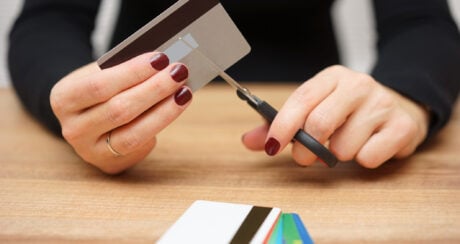Debt can feel like a weight, adding stress to your life and complications to your finances. If you owe money on your credit card, take steps to start paying off your balance.
The importance of paying off your credit card
Paying off a credit card is a satisfying experience because it not only means one less source of debt but also strongly signifies that you are on the right track financially. It’s not always that easy, however, especially if the statement balance has spiralled out of control and you’re indebted to the tune of several thousand dollars across several credit cards.
On the flip side, failure to repay credit card debt can be a recipe for disaster as the interest charged on the debt continues to accrue, and the total amount payable gets to the point where it can seem insurmountable.
Example of how credit card debt can grow:
Say you owe $2,000 on a credit card that charges 18% interest. If you only repaid the minimum, you’d pay a total of $5,691 over 18 years and 18 months. That’s an extra $3,691 worth of debt accumulated off interest alone — a 184.6% increase in what you originally owed.
Do as much research as possible before you apply for a credit card. Look into the terms and conditions, interest rates, and associated fees or charges. Consider what sort of credit limit you’re comfortable with and what the monthly repayments would be if you reached that limit. Remember that credit card interest rates are usually much higher than for other types of personal loans, such as mortgages, so paying them off ASAP should be a top priority for every cardholder.
When most people acquire a credit card, they have no intention of running the amount up to or near the limit, but often events conspire against us, and emergencies can appear from nowhere.
It is imperative to have a strategy in place to pay your credit card debt down as much as possible before the debt spirals out of control.
Strategies to pay off your credit card
Thankfully, there are active steps you can take to pay off the debt as early as possible and minimise the amount of interest you’ll have to pay on your card.
Make more than the minimum repayment
Banks and other card providers are not giving you credit out of the goodness of their hearts — they are trying to extract as much money from you as possible in the form of interest charged on the principal of the loan as well as whatever fees and charges they can extract over the course of the loan. That’s why they only charge you a relatively small amount as the minimum payable on the principal or closing monthly balance, so the debt continues to grow, and the lender ends up charging interest on as much of the principal as possible, which compounds over time. So, repaying more than the minimum so you can quickly pay off the principal before the interest amount bites is imperative.
As a quick aside, another strategy is to do the opposite and only pay the minimum while reinvesting the difference elsewhere for a potentially higher return that you can then use to pay off more of your debt. However, given how outrageous credit card interest rates can be, this strategy is fraught with danger and could be a lot costlier in the long run.
Do a balance transfer
Transferring balances from one credit card to another, usually with a different provider, makes perfect sense as most lenders offer an interest-free or low-interest introductory period between 6 and 18 months. If you owe $10,000 on a card with a current rate of 15% and transfer to a new card with a zero-interest rate for 12 months, you would save $1500 in that year.
However, there are pitfalls to be aware of if you do a balance transfer, such as the honeymoon period on the new card and when the actual rate comes into effect. Remember, banks are not giving you an interest-free loan because they like you, and they need new cardholders to stay with them for as long as possible post-transfer to maximise their earnings. You should also be aware that you have a new card and that using it over the interest-free period will be sorely tempting. Doing this will start the whole debt cycle all over again, though, which defeats the entire purpose of the balance transfer in the first place.
Balance transfers require discipline, or you could find yourself with a bigger balance than what you started with and a new interest rate of 20% or even higher at some stage down the track. Be mindful of the fees involved in balance transfers. No bank will offer this service free of charge from the outset, and one-off fees for a transfer can be anything up to $200. Also, if you can’t find a way to pay off the debt before the introductory rate period ends, you’ll need to be prepared to pay a potentially higher interest rate than your current one.
» MORE: What are zero-interest and interest-free credit cards?
Consolidate your debt
If you have more than one credit card, consolidating your debts under one umbrella makes perfect sense, not just from a cost-cutting point of view but also from a tracking and financial management perspective.
Use savings or other funds
Tapping into spare cash, of course, will not be a practical option for many cardholders, especially those experiencing financial hardship or just surviving paycheque to paycheque.
But, for those lucky enough to have some emergency funds set aside or access to other funds, possibly through a family member, it makes total sense to pay off any credit card debt with its accompanying interest rate.
Remember, there is a vast difference between the interest rate you’re paying on a credit card and the rate you might get with a term deposit.
» MORE: Need money now? 16 ways to get fast cash
Make a repayment plan with the lender
If your situation becomes dire and you have no income to repay the loan, you may have to devise a plan with the bank. Most big lenders in Australia provide some debt relief options for those struggling to repay loans due to a range of factors, including age, disability, sickness or employment termination, and they will, on occasion, waive part or even all of a loan.
If, for example, you owe $5000 on a card and are experiencing extreme financial hardship, your lender might agree to let you close the account for only $3000. Bear in mind that this will likely harm your credit rating and may make it much harder to acquire a loan for something else.
Whatever your situation, if you feel that you are losing control of your finances, it’s always a good idea to talk to your lender sooner rather than later so you can work out a mutually acceptable arrangement and hopefully get back on the right track.
» MORE: 7 money management skills to master ASAP
Seek help through debt relief
Finally, debt relief and financial hardship programs are available if you’re struggling and can’t repay your debt.
One such organisation is the financial charity Way Forward, which can help you by collecting your information, formulating a plan and talking to creditors on your behalf.
You can also talk to the National Debt Helpline, which has comprehensive debt solution plans on its website and alerts you to your rights.
DIVE EVEN DEEPER

How to Lower Your Bills: 33 Ways to Save Money
Chances are, you can cut costs and keep some cash in your pocket by taking a closer look at your bills.

Debt Collectors: What To Do If One Contacts You
A debt collector is a person or company that attempts to recover money owed. Know your rights when it comes to legal debt collection.

How To Cancel A Credit Card The Right Way
Before you cancel a credit card, know your reason, check transactions, pay off your balance, and redeem your rewards.

How To Lock, Block Or Freeze Your Credit Card
A card lock is essentially an on-off switch that allows you to temporarily freeze or block your credit card and most debit cards.

